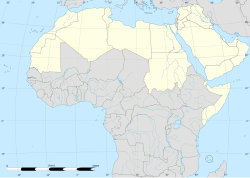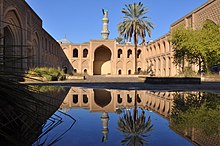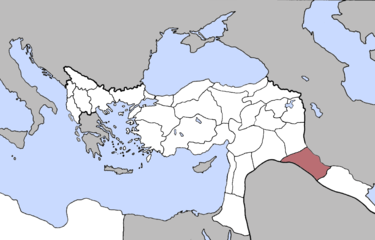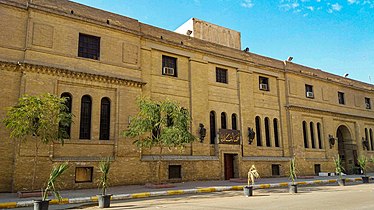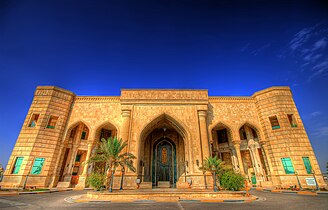Venue - UNDER CONSTRUCTION -
|
Baghdad
|
|
|---|---|
| Mayoralty of Baghdad | |
|
Clockwise from top: Aerial view of the Green Zone; Save Iraqi culture monument; Haydar-Khana Mosque; view of Baghdad and Tigris River; the Baghdadi Museum
|
|
| Nickname(s): The City of Peace
|
|
| Coordinates: 33°20'N 44°23'E ? / ? 33.333°N 44.383°E Coordinates: 33°20'N 44°23'E ? / ? 33.333°N 44.383°E ( 33°20'N 44°23'E ? / ? 33.333°N 44.383°E ) | |
| Country |
|
| Governorate | Baghdad |
| Established | 762 CE |
| Founded by | Caliph al-Mansur |
| Districts | 11 |
| Government | |
| · Type | Mayor‐council |
| · Body | Baghdad City Advisory Council |
| · Mayor | Alaa Al-Amari |
| Area | |
| · Total | 673 km 2 (260 sq mi) |
| Elevation | 34 m (112 ft) |
| Population | |
| · Estimate (2018)
|
8,126,755 |
| · Rank | 1st in Iraq |
| Demonym(s) | Baghdadi |
| Time zone | UTC+3 (Arabian Standard Time) |
| · Summer ( DST) | UTC+3 (No DST) |
| Postal code |
10001 to 10090
|
| Website | Mayoralty of Baghdad |
Baghdad is the capital of Iraq and the second-largest city in the Arab world after Cairo. It is located along the Tigris near the ruins of the ancient Akkadian city of Babylon and the Sassanid Persian capital of Ctesiphon. In the eighth century, Baghdad was chosen as the capital of the Abbasid Caliphate, and became its most notable major development project. Within a short time, the city evolved into a significant cultural, commercial, and intellectual center of the Muslim world. This, in addition to housing several key academic institutions, including the House of Wisdom, as well as a multiethnic and multi-religious environment, garnered it a worldwide reputation as the "Center of Learning".
Baghdad was the largest city in the world for much of the Abbasid era during the Islamic Golden Age, peaking at a population of more than a million. The city was largely destroyed at the hands of the Mongol Empire in 1258, resulting in a decline that would linger through many centuries due to frequent plagues and multiple successive empires. With the recognition of Iraq as an independent state (formerly the British Mandate of Mesopotamia) in 1932, Baghdad gradually regained some of its former prominence as a significant center of Arab culture, with a population variously estimated at 6 or over 7 million. Compared to its large population, it has a small area at just 673 square kilometers (260 sq mi).
The city has faced severe infrastructural damage due to the Iraq War, which began with the United States-led invasion of Iraq in 2003 and lasted until 2011, and the subsequent insurgency and renewed war that lasted until 2017, resulting in a substantial loss of cultural heritage and historical artifacts. During this period, Baghdad had one of the highest rates of terrorist attacks in the world. However, terrorist attacks have been rarer since the territorial defeat of the Islamic State militant group in Iraq in 2017.
History
Foundation

After the fall of the Umayyads, the first Muslim dynasty, the victorious Abbasid rulers wanted their own capital from which they could rule. They chose a site north of the Sassanid capital of Ctesiphon, and on 30 July 762 the caliph Al-Mansur commissioned the construction of the city. It was built under the guidance of the Barmakids. Mansur believed that Baghdad was the perfect city to be the capital of the Islamic empire under the Abbasids. The Muslim historian al-Tabari reported an ancient prediction by Christian monks that a lord named Miklas would one day build a spectacular city around the area of Baghdad. When Mansur heard the story, he became very joyful, for legend has it, he was called Miklas as a child. Mansur loved the site so much he is quoted saying: "This is indeed the city that I am to found, where I am to live, and where my descendants will reign afterward".
The city's growth was helped by its excellent location, based on at least two factors: it had control over strategic and trading routes along the Tigris, and it had an abundance of water in a dry climate. Water exists on both the north and south ends of the city, allowing all households to have a plentiful supply, which was quite uncommon during this time. The city of Baghdad quickly became so large that it had to be divided into three judicial districts: Madinat al-Mansur (the Round City), al-Sharqiyya (Karkh) and Askar al-Mahdi (on the West Bank).
Baghdad eclipsed Ctesiphon, the capital of the Sassanians, which was located some 30 km (19 mi) to the southeast. Today, all that remains of Ctesiphon is the shrine town of Salman Pak, just to the south of Greater Baghdad. Ctesiphon itself had replaced and absorbed Seleucia, the first capital of the Seleucid Empire, which had earlier replaced the city of Babylon.
According to the traveler Ibn Battuta, Baghdad was one of the largest cities, not including the damage it has received. The residents are mostly Hanbal. Baghdad is also home to the grave of Abu Hanifa where there is a cell and a mosque above it. The Sultan of Baghdad, Abu Said Bahadur Khan, was a Tatar king who embraced Islam.
In its early years, the city was known as a deliberate reminder of an expression in the Qur'an, when it refers to Paradise. It took four years to build (764‐768). Mansur assembled engineers, surveyors, and art constructionists from around the world to come together and draw up plans for the city. Over 100,000 construction workers came to survey the plans; many were distributed salaries to start the building of the city. July was chosen as the starting time because two astrologers, Naubakht Ahvazi and Mashallah, believed that the city should be built under the sign of the lion, Leo. Leo is associated with fire and symbolizes productivity, pride, and expansion.
The bricks used to make the city were 18 inches (460 mm) on all four sides. Abu Hanifah was the counter of the bricks and he developed a canal, which brought water to the work site for both human consumption and the manufacture of the bricks. Marble was also used to make buildings throughout the city, and marble steps led down to the river's edge.

The basic framework of the city consists of two large semicircles about 19 km (12 mi) in diameter. The city was designed as a circle about 2 km (1.2 mi) in diameter, leading it to be known as the "Round City". The original design shows a single ring of residential and commercial structures along the inside of the city walls, but the final construction added another ring inside the first. Within the city there were many parks, gardens, villas, and promenades. There was a large sanitation department, many fountains and public baths, and unlike contemporary European cities at the time, streets were frequently washed free of debris and trash. In fact, by the time of Harun al-Rashid, Baghdad had a few thousand hammams. These baths increased public hygiene and served as a way for the religious to perform ablutions as prescribed by Islam. Moreover, entry fees were usually so low that almost everyone could afford them. In the center of the city lay the mosque, as well as headquarters for guards. The purpose or use of the remaining space in the center is unknown. The circular design of the city was a direct reflection of the traditional Persian Sasanian urban design. The Sasanian city of Gur in Fars, built 500 years before Baghdad, is nearly identical in its general circular design, radiating avenues, and the government buildings and temples at the center of the city. This style of urban planning contrasted with Ancient Greek and Roman urban planning, in which cities are designed as squares or rectangles with streets intersecting each other at right angles.
Baghdad was a hectic city during the day and had many attractions at night. There were cabarets and taverns, halls for backgammon and chess, live plays, concerts, and acrobats. On street corners, storytellers engaged crowds with tales such as those later told in Arabian Nights.
- Surrounding walls
The four surrounding walls of Baghdad were named Kufa, Basra, Khurasan, and Syria; named because their gates pointed in the directions of these destinations. The distance between these gates was a little less than 2.4 km (1.5 mi). Each gate had double doors that were made of iron; the doors were so heavy it took several men to open and close them. The wall itself was about 44 m thick at the base and about 12 m thick at the top. Also, the wall was 30 m high, which included merlons, a solid part of an embattled parapet usually pierced by embrasures. This wall was surrounded by another wall with a thickness of 50 m. The second wall had towers and rounded merlons, which surrounded the towers. This outer wall was protected by a solid glacis, which is made out of bricks and quicklime. Beyond the outer wall was a water-filled moat. [ citation needed ]
- Golden Gate Palace
The Golden Gate Palace, the residence of the caliph and his family, was in the heart of Baghdad, in the central square. In the central part of the building, there was a green dome that was 39 m high. Surrounding the palace was an esplanade, a waterside building, in which only the caliph could come riding on horseback. In addition, the palace was near other mansions and officer's residences. Near the Gate of Syria, a building served as the home for the guards. It was made of brick and marble. The palace governor lived in the latter part of the building and the commander of the guards in the front. In 813, after the death of caliph Al-Amin, the palace was no longer used as the home for the caliph and his family. The roundness points to the fact that it was based on Arabic script. The two designers who were hired by Al-Mansur to plan the city's design were Naubakht, a Zoroastrian who also determined that the date of the foundation of the city would be astrologically auspicious, and Mashallah, a Jew from Khorasan, Iran.
Center of learning (8th‐9th centuries)
Within a generation of its founding, Baghdad became a hub of learning and commerce. The city flourished into an unrivaled intellectual center of science, medicine, philosophy, and education, especially with the Abbasid translation movement began under the second caliph Al-Mansur and thrived under the seventh caliph Al-Ma'mun. Baytul-Hikmah or the "House of Wisdom" was among the most well known academies, and had the largest selection of books in the world by the middle of the 9th century. [ citation needed ] Notable scholars based in Baghdad during this time include translator Hunayn ibn Ishaq, mathematician al-Khwarizmi, and philosopher Al-Kindi. Although Arabic was used as the international language of science, the scholarship involved not only Arabs, but also Persians, Syriacs, Nestorians, Jews, Arab Christians, and people from other ethnic and religious groups native to the region. These are considered among the fundamental elements that contributed to the flourishing of scholarship in the Medieval Islamic world. Baghdad was also a significant center of Islamic religious learning, with Al-Jahiz contributing to the formation of Mu'tazili theology, as well as Al-Tabari culminating in the scholarship on the Quranic exegesis. Baghdad was likely the largest city in the world from shortly after its foundation until the 930s, when it tied with Córdoba. Several estimates suggest that the city contained over a million inhabitants at its peak. Many of the One Thousand and One Nights tales, widely known as the Arabian Nights, are set in Baghdad during this period. It would surpass even Constantinople in prosperity and size.
Among the notable features of Baghdad during this period were its exceptional libraries. Many of the Abbasid caliphs were patrons of learning and enjoyed collecting both ancient and contemporary literature. Although some of the princes of the previous Umayyad dynasty had begun to gather and translate Greek scientific literature, the Abbasids were the first to foster Greek learning on a large scale. Many of these libraries were private collections intended only for the use of the owners and their immediate friends, but the libraries of the caliphs and other officials soon took on a public or a semi-public character. Four great libraries were established in Baghdad during this period. The earliest was that of the famous Al-Ma'mun, who was caliph from 813 to 833. Another was established by Sabur ibn Ardashir in 991 or 993 for the literary men and scholars who frequented his academy. Unfortunately, this second library was plundered and burned by the Seljuks only seventy years after it was established. This was a good example of the sort of library built up out of the needs and interests of a literary society. The last two were examples of madrasa or theological college libraries. The Nezamiyeh was founded by the Persian Nizam al-Mulk, who was vizier of two early Seljuk sultans. It continued to operate even after the coming of the Mongols in 1258. The Mustansiriyah madrasa , which owned an exceedingly rich library, was founded by Al-Mustansir, the second last Abbasid caliph, who died in 1242. This would prove to be the last great library built by the caliphs of Baghdad.
Stagnation and invasions (10th‐16th centuries)
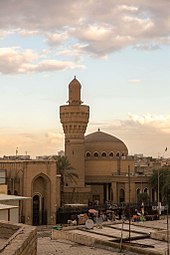

By the 10th century, the city's population was between 1.2 million and 2 million. Baghdad's early meteoric growth eventually slowed due to troubles within the Caliphate, including relocations of the capital to Samarra (during 808‐819 and 836‐892), the loss of the western and easternmost provinces, and periods of political domination by the Iranian Buwayhids (945‐1055) and Seljuk Turks (1055‐1135).
The Seljuks were a clan of the Oghuz Turks from Central Asia that converted to the Sunni branch of Islam. In 1040, they destroyed the Ghaznavids, taking over their land and in 1055, Tughril Beg, the leader of the Seljuks, took over Baghdad. The Seljuks expelled the Buyid dynasty of Shiites that had ruled for some time and took over power and control of Baghdad. They ruled as Sultans in the name of the Abbasid caliphs (they saw themselves as being part of the Abbasid regime). Tughril Beg saw himself as the protector of the Abbasid Caliphs.
Sieges and wars in which Baghdad was involved are listed below:
- Siege of Baghdad (812‐813), Fourth Fitna (Caliphal Civil War)
- Siege of Baghdad (865), Abbasid civil war (865‐866)
- Battle of Baghdad (946), Buyid‐Hamdanid War
- Siege of Baghdad (1157), Abbasid‐Seljuq Wars
- Siege of Baghdad (1258), Mongol conquest of Baghdad
- Siege of Baghdad (1393), by Tamerlane
- Siege of Baghdad (1401), by Tamerlane
- Capture of Baghdad (1534), Ottoman‐Safavid Wars
- Capture of Baghdad (1623), Ottoman‐Safavid Wars
- Capture of Baghdad (1638), Ottoman‐Safavid Wars
In 1058, Baghdad was captured by the Fatimids under the Turkish general Abu'l-?arith Arslan al-Basasiri, an adherent of the Ismailis along with the 'Uqaylid Quraysh. Not long before the arrival of the Saljuqs in Baghdad, al-Basasiri petitioned to the Fatimid Imam-Caliph al-Mustansir to support him in conquering Baghdad on the Ismaili Imam's behalf. It has recently come to light that the famed Fatimid da'i , al-Mu'ayyad al-Shirazi, had a direct role in supporting al-Basasiri and helped the general to succeed in taking Maw?il, Wasit and Kufa. Soon after, by December 1058, a Shi'i adhan (call to prayer) was implemented in Baghdad and a khutbah (sermon) was delivered in the name of the Fatimid Imam-Caliph. Despite his Shi'i inclinations, Al-Basasiri received support from Sunnis and Shi'is alike, for whom opposition to the Saljuq power was a common factor.
On 10 February 1258, Baghdad was captured by the Mongols led by Hulegu, a grandson of Chingiz Khan ( Genghis Khan), during the siege of Baghdad. Many quarters were ruined by fire, siege, or looting. The Mongols massacred most of the city's inhabitants, including the caliph Al-Musta'sim, and destroyed large sections of the city. The canals and dykes forming the city's irrigation system were also destroyed. During this time, in Baghdad, Christians and Shia were tolerated, while Sunnis were treated as enemies. The sack of Baghdad put an end to the Abbasid Caliphate. It has been argued that this marked an end to the Islamic Golden Age and served a blow from which Islamic civilization never fully recovered.
At this point, Baghdad was ruled by the Ilkhanate, a breakaway state of the Mongol Empire, ruling from Iran. In August 1393, Baghdad was occupied by the Central Asian Turkic conqueror Timur ("Tamerlane"), by marching there in only eight days from Shiraz. Sultan Ahmad Jalayir fled to Syria, where the Mamluk Sultan Barquq protected him and killed Timur's envoys. Timur left the Sarbadar prince Khwaja Mas'ud to govern Baghdad, but he was driven out when Ahmad Jalayir returned.
In 1401, Baghdad was again sacked, by Timur. When his forces took Baghdad, he spared almost no one, and ordered that each of his soldiers bring back two severed human heads. Baghdad became a provincial capital controlled by the Mongol Jalayirid (1400‐1411), Turkic Kara Koyunlu (1411‐1469), Turkic Ak Koyunlu (1469‐1508), and the Iranian Safavid (1508‐1534) dynasties.
Ottoman era (16th‐19th centuries)
In 1534, Baghdad was captured by the Ottoman Turks. Under the Ottomans, Baghdad continued into a period of decline, partially as a result of the enmity between its rulers and Iranian Safavids, which did not accept the Sunni control of the city. Between 1623 and 1638, it returned to Iranian rule before falling back into Ottoman hands. Baghdad has suffered severely from visitations of the plague and cholera, and sometimes two-thirds of its population has been wiped out.
For a time, Baghdad had been the largest city in the Middle East. The city saw relative revival in the latter part of the 18th century, under a Mamluk government. Direct Ottoman rule was reimposed by Ali Riza Pasha in 1831. From 1851 to 1852 and from 1861 to 1867, Baghdad was governed, under the Ottoman Empire by Mehmed Namik Pasha. The Nuttall Encyclopedia reports the 1907 population of Baghdad as 185,000.
-
Baghdad Eyalet in 1609 CE.
-
Baghdad Vilayet in 1900 CE.
Modern era
Baghdad and southern Iraq remained under Ottoman rule until 1917, when they were captured by the British during World War I. In 1920, Baghdad became the capital of the British Mandate of Mesopotamia, with several architectural and planning projects commissioned to reinforce this administration. After receiving independence in 1932, the city became capital of the Kingdom of Iraq.
During this period, the substantial Jewish community (probably exceeding 100,000 people) comprised between a quarter and a third of the city's population. On 1 April 1941, members of the "Golden Square" and Rashid Ali staged a coup in Baghdad. Rashid Ali installed a pro- German and pro- Italian government to replace the pro-British government of Regent Abdul Ilah. On 31 May, after the resulting Anglo-Iraqi War and after Rashid Ali and his government had fled, the Mayor of Baghdad surrendered to British and Commonwealth forces. On June 1‐2, during the ensuing power vacuum, Jewish residents were attacked following rumors they had aided the British. In what became known as the Farhud, over 180 Jews were killed, 1,000 injured and hundreds of Jewish properties were ransacked. Between 300 and 400 non-Jewish rioters were killed in the attempt to quell the violence.
The city's population grew from an estimated 145,000 in 1900 to 580,000 in 1950. On 14 July 1958, members of the Iraqi Army, under Abd al-Karim Qasim, staged a coup to topple the Kingdom of Iraq. King Faisal II, former Prime Minister Nuri as-Said, former Regent Prince 'Abd al-Ilah, members of the royal family, and others were brutally killed during the coup. Many of the victim's bodies were then dragged through the streets of Baghdad.
During the 1970s, Baghdad experienced a period of prosperity and growth because of a sharp increase in the price of petroleum, Iraq's main export. New infrastructure including modern sewerage, water, and highway facilities were built during this period. The masterplans of the city (1967, 1973) were delivered by the Polish planning office Miastoprojekt-Kraków, mediated by Polservice. However, the Iran‐Iraq War of the 1980s was a difficult time for the city, as money was diverted by Saddam Hussein to the army and thousands of residents were killed. Iran launched a number of missile attacks against Baghdad in retaliation for Saddam Hussein's continuous bombardments of Tehran's residential districts. In 1991 and 2003, the Gulf War and the US invasion of Iraq caused significant damage to Baghdad's transportation, power, and sanitary infrastructure as the US-led coalition forces launched massive aerial assaults in the city in the two wars. Also in 2003, a minor riot in the city (which took place on 21 July) caused some disturbance in the population. The historic "Assyrian Quarter" of the city, Dora, which boasted a population of 150,000 Assyrians in 2003, made up over 3% of the capital's Assyrian population then. The community has been subject to kidnappings, death threats, vandalism, and house burnings by al-Qaeda and other insurgent groups. As of the end of 2014, only 1,500 Assyrians remained in Dora. The Iraq War took place from 2003 to 2011, but an Islamist insurgency lasted until 2013. It was followed by another war from 2013 to 2017 and a low-level insurgency from 2017, which included suicide bombings in January 2018 and January 2021. Priceless collection of artifacts in the National Museum of Iraq was looted by the Iraqi citizens during the 2003 US-led invasion. Thousands of ancient manuscripts in the National Library were destroyed.
Reconstruction efforts
Most Iraqi reconstruction efforts have been devoted to the restoration and repair of badly damaged urban infrastructure. More visible efforts at reconstruction through private development, like architect and urban designer Hisham N. Ashkouri's Baghdad Renaissance Plan and the Sindbad Hotel Complex and Conference Center have also been made. A plan was proposed by a Government agency to rebuild a tourist island in 2008. Investors were sought to develop a "romantic island" on the River Tigris that was once a popular honeymoon spot for newlyweds. The project would include a six-star hotel, spa, an 18-hole golf course and a country club. In addition, the go-ahead has been given to build numerous architecturally unique skyscrapers along the Tigris that would develop the city's financial center in Kadhehemiah. In late 2009, a construction plan was proposed to rebuild the heart of Baghdad, but the plan was never realized because corruption was involved in it.
The Baghdad Eye ferris wheel, proposed in August 2008, was installed at the Al-Zawraa Park in March 2011. In May 2010, a new large scale residential and commercial project called Baghdad Gate was announced.
In August 2010, Iraqi-British architect Zaha Hadid, was appointed to design a new headquarters for the Central Bank in Baghdad. Initial talks about the project were held in Istanbul, Turkey, on 14 August 2010, in the presence of the Central Bank Governor Sinan Al Shabibi. On 2 February 2012, Zaha Hadid joined Sinan Al Shabibi at a ceremony in London to sign the agreement between the Central Bank of Iraq and Zaha Hadid Architects for the design stages of the new CBI Headquarters building. The construction was postponed in 2015 due to economical problems, but started again in 2019.
Climate
Baghdad has a hot desert climate ( Köppen BWh), featuring extremely hot, prolonged, dry summers and mild to cool, slightly wet, short winters. In the summer, from June through August, the average maximum temperature is as high as 44 °C (111 °F) and accompanied by sunshine. Rainfall has been recorded on fewer than half a dozen occasions at this time of year and has never exceeded 1 millimeter (0.04 in). Even at night, temperatures in summer are seldom below 24 °C (75 °F). Baghdad's record highest temperature of 51.8 °C (125.2 °F) was reached on 28 July 2020. The humidity is typically under 50% in summer due to Baghdad's distance from the marshy southern Iraq and the coasts of Persian Gulf, and dust storms from the deserts to the west are a normal occurrence during the summer.
Winter temperatures are typical of hot desert climates. From December through February, Baghdad has maximum temperatures averaging 16 to 19 °C (61 to 66 °F), though highs above 21 °C (70 °F) are not unheard of. Lows below freezing occur a couple of times per year on average.
Annual rainfall, almost entirely confined to the period from November through March, averages approximately 150 mm (5.91 in), but has been as high as 338 mm (13.31 in) and as low as 37 mm (1.46 in). On 11 January 2008, light snow fell across Baghdad for the first time in 100 years. Snowfall was again reported on 11 February 2020, with accumulations across the city.
| Climate data for Baghdad | |||||||||||||
|---|---|---|---|---|---|---|---|---|---|---|---|---|---|
| Month | Jan | Feb | Mar | Apr | May | Jun | Jul | Aug | Sep | Oct | Nov | Dec | Year |
| Average high °C (°F) | 15.5 (59.9) |
18.5 (65.3) |
23.6 (74.5) |
29.9 (85.8) |
36.5 (97.7) |
41.3 (106.3) |
44.0 (111.2) |
43.5 (110.3) |
40.2 (104.4) |
33.4 (92.1) |
23.7 (74.7) |
17.2 (63.0) |
30.6 (87.1) |
| Daily mean °C (°F) | 9.7 (49.5) |
12 (54) |
16.6 (61.9) |
22.6 (72.7) |
28.3 (82.9) |
32.3 (90.1) |
34.8 (94.6) |
34 (93) |
30.5 (86.9) |
24.7 (76.5) |
16.5 (61.7) |
11.2 (52.2) |
22.8 (73.0) |
| Average low °C (°F) | 3.8 (38.8) |
5.5 (41.9) |
9.6 (49.3) |
15.2 (59.4) |
20.1 (68.2) |
23.3 (73.9) |
25.5 (77.9) |
24.5 (76.1) |
20.7 (69.3) |
15.9 (60.6) |
9.2 (48.6) |
5.1 (41.2) |
14.9 (58.8) |
| Average rainfall mm (inches) | 26 (1.0) |
28 (1.1) |
28 (1.1) |
17 (0.7) |
7 (0.3) |
0 (0) |
0 (0) |
0 (0) |
0 (0) |
3 (0.1) |
21 (0.8) |
26 (1.0) |
156 (6.1) |
| Average rainy days | 5 | 5 | 6 | 4 | 2 | 0 | 0 | 0 | 0 | 1 | 5 | 6 | 34 |
| Average relative humidity (%) | 71 | 61 | 53 | 43 | 30 | 21 | 22 | 22 | 26 | 34 | 54 | 71 | 42 |
| Mean monthly sunshine hours | 192.2 | 203.4 | 244.9 | 255.0 | 300.7 | 348.0 | 347.2 | 353.4 | 315.0 | 272.8 | 213.0 | 195.3 | 3,240.9 |
| Average ultraviolet index | 3 | 4 | 6 | 8 | 10 | 11 | 11 | 10 | 9 | 6 | 4 | 3 | 7 |
| Source 1: World Meteorological Organization ( UN) | |||||||||||||
| Source 2: Climate & Temperature | |||||||||||||
Geography
The city is located on a vast plain bisected by the Tigris river. The Tigris splits Baghdad in half, with the eastern half being called " Risafa" and the Western half known as " Karkh". The land on which the city is built is almost entirely flat and low-lying, being of alluvial origin due to the periodic large floods which have occurred on the river.
Tourism
Baghdad was once one of the main destinations in the country and the region with a wealth of cultural attractions. Tourism has diminished since the Iraq-Iran war and later during the US invasion, but in recent years Baghdad has become a main tourist destination although it is still facing challenges.
There are numerous historic, scientific and artistic museums in Baghdad which include, Iraq Museum, Baghdadi Museum, Natural History Museum and several others.
Baghdad is known for its famous Mutanabbi street which is well established for bookselling and has often been referred to as the heart and soul of the Baghdad literacy and intellectual community. The annual International Book Fair in Baghdad is a well known to the international publishing world as a promising publishing event in the region after years of instability.







